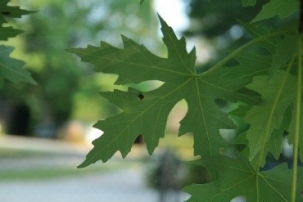Silver maple (Acer saccharinum; Érable argenté) is a native tree that grows best in moist sites. It is common in southern Quebec and also in Montreal (Espace Pour La Vie Montreal, n.d.).
The name Silver maple comes from the silver-white undersides of its sharp-toothed leaves, which give it a silver-white sheen when viewed from below. The leaves area also deeply lobed, more so than those of other local maples.
In the fall, the leaves turn pale yellow or brown, rarely red. They are usually relatively fast growing, which has made them a common choice for urban planting. However, their fast growth and soft wood also makes them very susceptible to weather and fungal damage.
Although Silver maple wood can be easily broken, its cavities serve as homes to squirrels, raccoons, and many cavity-nesting birds like Black-backed Chickadees, which are common in the Montreal area. Moreover, the sap and buds of the Silver maple provide an early-spring source of food for squirrels when their food supplies are depleted (Sullivan, 1994).
As of 2023, the Silver maple was one of the most common trees at Concordia, second only to the Norway maple. It is the most common street tree in Montreal (Quebec Centre for Biodiversity Science, 2023). In addition, the largest and oldest tree on the Loyola campus is a Silver maple, located just northeast of the Chapel facing the Vanier Library. This stunning tree was last measured at 129 cm in diameter at breast height; based on a growth factor of 3.0 for this species (Purcell, 2018), that makes this tree over 150 years old! According to the iTree model, this tree liklley results in an electricity savings of almost 44 kWh/year (mostly due to savings in cooling) and currently stores over 4400 kg of carbon. It also filters the air and water and provides countless other ecosystem services.
References
- Government of Canada, Natural Resources Canada. (2015). Red oak. Government of Canada, Natural Resources Canada. Retrieved January 26, 2023, from https://tidcf.nrcan.gc.ca/en/trees/factsheet/85
- Espace Pour La Vie Montreal (n.d.). Green Pages: Silver maple. Espace Pour La Vie Montreal. Retrieved January 30, 2023, from https://espacepourlavie.ca/en/green-pages/silver-maple
- One Tree Planted. (n.d.). Types of Tree Species. One Tree Planted. Retrieved January 29, 2023, from https://onetreeplanted.org/pages/types-of-trees-species
- Quebec Centre for Biodiversity Science (2023). Public trees of Montreal. https://www.quebio.ca/en.
- Sullivan, J. (1994). Acer saccharinum. In: Fire Effects Information System, [Online]. U.S. Department of Agriculture, Forest Service, Rocky Mountain Research Station, Fire Sciences Laboratory (Producer). Retrieved January 26, 2023, from https://www.fs.usda.gov/database/feis/plants/tree/acesah/all.html


 Silver maple leaves
Silver maple leaves